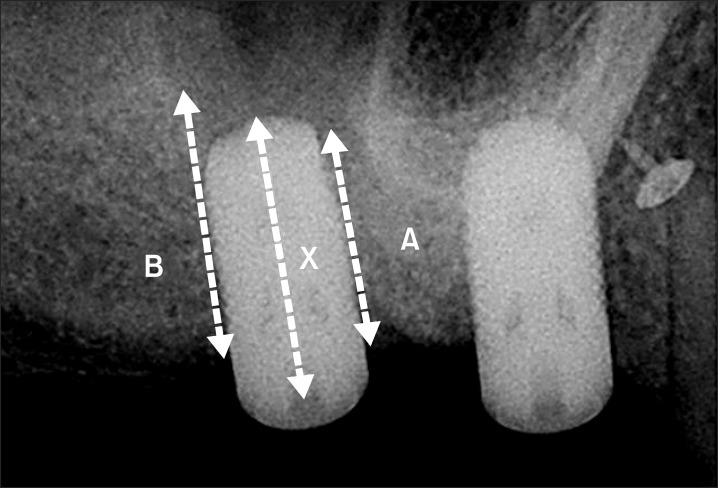J Korean Assoc Oral Maxillofac Surg.
2014 Feb;40(1):17-20. 10.5125/jkaoms.2014.40.1.17.
Survival rate of Astra Tech implants with maxillary sinus lift
- Affiliations
-
- 1Department of Oral and Maxillofacial Surgery, School of Dentistry, Chosun University, Gwangju, Korea. sgckim@chosun.ac.kr
- KMID: 1960967
- DOI: http://doi.org/10.5125/jkaoms.2014.40.1.17
Abstract
OBJECTIVES
The aim of this study was to retrospectively evaluate the clinical survival rate of Astra Tech implants in the maxillary molar region performed with sinus lift and bone graft.
MATERIALS AND METHODS
Ninety-nine Astra Tech implants (Osseospeed) placed in the maxillary molar region using sinus lift from September 2009 to February 2012 were selected with a minimum follow-up period of 1 year. The height of alveolar bone, sinus approach technique, bone material and implant survival rate were evaluated.
RESULTS
Of the 99 implants, the survival rate was 90.9%; 8 implants failed within 1 year after implant placement, and 1 implant failed 1 year after implant loading. All failed implants were placed with sinus lift simultaneously. The average height of alveolar bone before implant placement was 6.9 mm, while the height of alveolar bone of failed implants was 2.1 mm, on average.
CONCLUSION
Astra Tech implants placed in the maxillary molar region had generally good survival rates, but the relationship between reduced pre-implant alveolar bone height and implant failure requires further attention.
Keyword
MeSH Terms
Figure
Cited by 1 articles
-
Commentary to "Survival rate of Astra Tech implants with maxiilary sinus lift"
Junho Lee
J Korean Assoc Oral Maxillofac Surg. 2014;40(2):96-97. doi: 10.5125/jkaoms.2014.40.2.96.
Reference
-
1. Chaushu G, Mardinger O, Calderon S, Moses O, Nissan J. The use of cancellous block allograft for sinus floor augmentation with simultaneous implant placement in the posterior atrophic maxilla. J Periodontol. 2009; 80:422–428. PMID: 19254126.
Article2. Nyström E, Ahlqvist J, Legrell PE, Kahnberg KE. Bone graft remodelling and implant success rate in the treatment of the severely resorbed maxilla: a 5-year longitudinal study. Int J Oral Maxillofac Surg. 2002; 31:158–164. PMID: 12102413.
Article3. Cricchio G, Sennerby L, Lundgren S. Sinus bone formation and implant survival after sinus membrane elevation and implant placement: a 1- to 6-year follow-up study. Clin Oral Implants Res. 2011; 22:1200–1212. PMID: 21906186.
Article4. Bruschi GB, Crespi R, Capparè P, Gherlone E. Transcrestal sinus floor elevation: a retrospective study of 46 patients up to 16 years. Clin Implant Dent Relat Res. 2012; 14:759–767. PMID: 20977614.
Article5. Hürzeler MB, Quiñones CR, Kirsch A, Gloker C, Schüpbach P, Strub JR, et al. Maxillary sinus augmentation using different grafting materials and dental implants in monkeys. Part I. Evaluation of anorganic bovine-derived bone matrix. Clin Oral Implants Res. 1997; 8:476–486. PMID: 9580407.6. Lee HJ, Choi BH, Jung JH, Zhu SJ, Lee SH, Huh JY, et al. Maxillary sinus floor augmentation using autogenous bone grafts and platelet-enriched fibrin glue with simultaneous implant placement. Oral Surg Oral Med Oral Pathol Oral Radiol Endod. 2007; 103:329–333. PMID: 17321442.
Article7. Astrand P, Nord PG, Branemark PI. Titanium implants and onlay bone graft to the atrophic edentulous maxilla: a 3-year longitudinal study. Int J Oral Maxillofac Surg. 1996; 25:25–29. PMID: 8833296.8. Mardinger O, Nissan J, Chaushu G. Sinus floor augmentation with simultaneous implant placement in the severely atrophic maxilla: technical problems and complications. J Periodontol. 2007; 78:1872–1877. PMID: 18062109.
Article9. Rapani M, Rapani C. Sinus floor lift and simultaneous implant placement: a retrospective evaluation of implant success rate. Indian J Dent. 2012; 3:132–138.
Article10. Jurisic M, Markovic A, Radulovic M, Brkovic BM, Sándor GK. Maxillary sinus floor augmentation: comparing osteotome with lateral window immediate and delayed implant placements. An interim report. Oral Surg Oral Med Oral Pathol Oral Radiol Endod. 2008; 106:820–827. PMID: 18602304.
Article11. Anavi Y, Allon DM, Avishai G, Calderon S. Complications of maxillary sinus augmentations in a selective series of patients. Oral Surg Oral Med Oral Pathol Oral Radiol Endod. 2008; 106:34–38. PMID: 18299227.
Article12. Tang ZH, Wu MJ, Xu WH. Implants placed simultaneously with maxillary sinus floor augmentations in the presence of antral pseudocysts: a case report. Int J Oral Maxillofac Surg. 2011; 40:998–1001. PMID: 21596525.
Article13. Cha HS, Kim A, Nowzari H, Chang HS, Ahn KM. Simultaneous sinus lift and implant installation: prospective study of consecutive two hundred seventeen sinus lift and four hundred sixty-two implants. Clin Implant Dent Relat Res. 2012; doi: 10.1111/cid.12012[Epub ahead of print].
Article
- Full Text Links
- Actions
-
Cited
- CITED
-
- Close
- Share
- Similar articles
-
- Commentary to "Survival rate of Astra Tech implants with maxiilary sinus lift"
- A clinical study of maxillary sinus lift for dental implant
- Cumulative survival rate of Astra Tech implants: a retrospective analysis
- A Retrospective study on the survival rate of the sinus perforated implants
- Implant Survival Rates of Maxillary Sinus Augmentation: a Literature Review of Graft Materials


